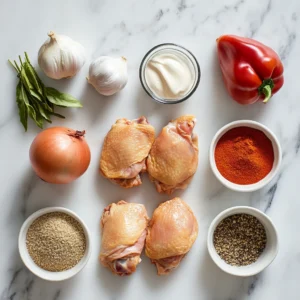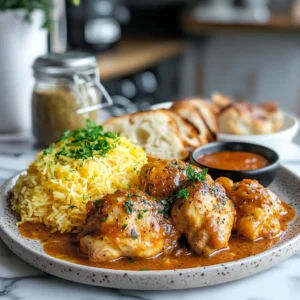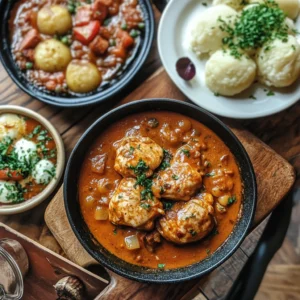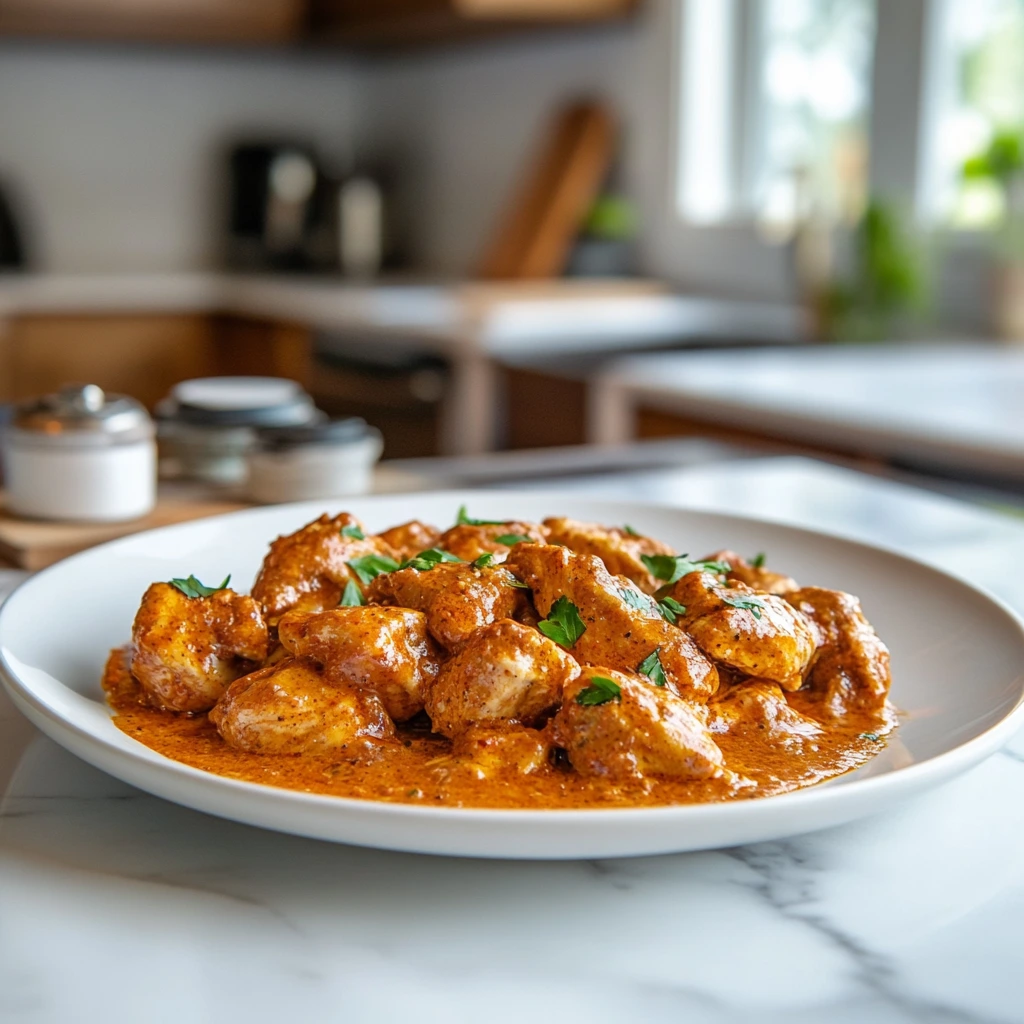Hungarian cuisine is full of rich flavors, hearty meals, and dishes that bring families together around the dinner table. Among these, chicken paprikash stands out as one of the most cherished and comforting recipes. With its creamy, paprika-infused sauce and tender chicken, it is a dish that has stood the test of time, passed down through generations and loved worldwide. Whether you are new to Hungarian food or a seasoned cook looking to perfect your chicken paprikash, this guide will walk you through its history, ingredients, preparation, and expert tips to make it just right.
Introduction
If you’re searching for a comforting, richly flavored dish that embodies the essence of Hungarian cuisine, then chicken paprikash is the perfect choice. This dish has been a staple in Hungarian households for generations, featuring a deliciously creamy paprika sauce enveloping tender chicken.
This guide will take you through everything you need to know about authentic chicken paprikash, from its origins and cultural significance to the best ingredients, step-by-step preparation, variations, common mistakes, and expert tips. By the end of this article, you’ll have all the knowledge you need to prepare a restaurant-quality dish at home.
The History and Origins of Chicken Paprikash
Chicken Paprikash, known as Paprikás Csirke in Hungarian, is a national treasure. The dish originates from Hungary’s Great Plains region, where paprika became a defining element of the country’s cuisine. The use of paprika in Hungarian dishes dates back to the 16th century when it was introduced through trade routes.
Initially, Hungarian cuisine relied heavily on meats, root vegetables, and simple seasonings. The introduction of paprika revolutionized their culinary traditions, adding depth, color, and unique flavor to many dishes, including stews and soups. Chicken paprikash quickly became one of the most beloved dishes due to its simplicity and affordability.
During the Austro-Hungarian Empire, this dish spread beyond Hungary’s borders, becoming popular in neighboring countries like Austria, Slovakia, and parts of Romania. Each region adapted it slightly, but the core elements—chicken, paprika, and a creamy sauce—remained unchanged.
Over time, chicken paprikash evolved from a simple peasant dish into a beloved comfort food enjoyed by all classes. The introduction of sour cream, likely influenced by neighboring European cuisines, added the signature creamy texture that defines the modern version of the dish. Today, chicken paprikash is one of Hungary’s most iconic meals, often served during family gatherings and festive occasions.
In Hungarian households, this dish is passed down through generations, with each family adding its own unique touch, whether it’s through additional spices, serving styles, or cooking methods.
What Makes an Authentic Chicken Paprikash?
Key Characteristics
A true chicken paprikash is defined by:
- The use of bone-in chicken (typically drumsticks and thighs) for maximum flavor.
- Hungarian sweet paprika, which provides a rich red color and deep flavor.
- A sauce made from slow-cooked onions, garlic, chicken broth, and sour cream.
- The absence of excessive spices—this dish highlights the pure taste of paprika.
- Traditional accompaniments such as nokedli (Hungarian dumplings) or buttered egg noodles.
While there are variations of chicken paprikash across regions, an authentic preparation always stays true to its Hungarian roots by prioritizing quality paprika and a slow-simmered sauce.
Why Hungarian Paprika is Essential
One of the most critical elements of chicken paprikash is using authentic Hungarian sweet paprika. This spice is made from dried red peppers and is known for its bright red hue and rich, slightly sweet flavor. Unlike generic paprika found in most supermarkets, Hungarian paprika has a more intense and authentic taste, which makes a significant difference in the dish’s final flavor.
There are several types of Hungarian paprika, but for chicken paprikash, sweet paprika is the most commonly used. Some variations may include hot paprika for an extra kick, but the traditional recipe emphasizes the mild, rich flavor of sweet paprika.

Perfect Chicken Paprikash
Equipment
- Large Pan or Dutch Oven
Ingredients
Essential Ingredients
- 2 lbs bone-in chicken thighs or drumsticks skin-on for more depth of flavor
- 2 tbsp Hungarian sweet paprika do not substitute with smoked paprika
- 1 large onion finely chopped
- 2 cloves garlic minced
- 2 tbsp vegetable oil or lard for authentic taste, lard is recommended
- 1 cup chicken broth
- 1/2 cup sour cream room temperature, to prevent curdling
- Salt and black pepper to taste
Optional Ingredients
- 1 small tomato diced
- 1 bell pepper sliced thinly
- 1 tsp caraway seeds for additional depth in flavor
- 1 tbsp flour to help thicken the sauce if necessary
Instructions
- Pat the chicken dry and season with salt and pepper.
- In a large pan or Dutch oven, heat oil or lard over medium-high heat.
- Sear the chicken on all sides until golden brown (about 5 minutes per side). Remove and set aside.
- In the same pan, reduce heat to medium and add chopped onions.
- Sauté until the onions are soft and translucent, about 5 minutes.
- Add minced garlic and cook for another 30 seconds.
- Remove the pan from the heat and stir in the paprika (this prevents it from burning and turning bitter).
- Return to low heat and add chicken broth, scraping the bottom to release all the flavorful bits.
- Return the browned chicken to the pan, cover, and let it simmer for 30–40 minutes.
- Remove the chicken and set it aside.
- In a small bowl, mix sour cream with 2 tbsp of sauce to temper it, then gradually stir back into the pan.
- If the sauce needs thickening, add 1 tbsp flour mixed with 2 tbsp water.
- Return the chicken to the pot and let it simmer for another 5 minutes.
- Serve hot over nokedli, egg noodles, or mashed potatoes.
- Garnish with fresh parsley for color and extra flavor.
Notes
Best Side Dishes for Chicken Paprikash

Traditional Accompaniments
If you’re looking for premium Hungarian paprika to elevate your dish, check out this selection of authentic Hungarian paprika to ensure the best flavor.
- Nokedli (Hungarian Dumplings): These small, soft dumplings are the most traditional accompaniment to chicken paprikash. They are similar to German spätzle and perfectly soak up the creamy paprika sauce.
- Made from a simple dough of flour, eggs, water, and salt, they are quickly prepared by pushing the dough through a dumpling maker or grating it into boiling water.
- Once cooked, they are lightly buttered to prevent sticking and to enhance their flavor.
- Some variations include adding sour cream or cheese for an even richer texture.
- Egg Noodles: Buttered egg noodles serve as a quick and easy alternative to nokedli.
- Their soft, slightly chewy texture makes them ideal for absorbing the sauce.
- A touch of melted butter or olive oil adds extra richness.
- Freshly chopped parsley can be sprinkled on top for added color and freshness.
- Mashed Potatoes: Creamy mashed potatoes are another excellent pairing for chicken paprikash.
- The smooth and fluffy texture contrasts beautifully with the hearty chicken and rich sauce.
- A dollop of sour cream or a bit of heavy cream in the potatoes complements the flavors in the dish.
- Roasted garlic or caramelized onions can be incorporated into the mash for an added depth of flavor.
Additional Side Dish Ideas

- Rice Pilaf: Light and fluffy rice, often cooked with a touch of butter and chicken broth, can be a great base to balance the richness of the sauce.
- Steamed or Roasted Vegetables: Simple steamed carrots, green beans, or roasted Brussels sprouts provide a fresh contrast to the creamy dish.
- Crusty Bread or Baguette: A slice of rustic bread is perfect for soaking up the flavorful sauce and is a great option for those who prefer a lighter side dish.
- Cucumber Salad: A light and tangy cucumber salad dressed with vinegar and dill adds a refreshing element to balance the dish’s richness.
For more tips on mashing potatoes efficiently, read about the best potato masher tools.
Conclusion
Chicken paprikash is an easy yet elegant dish that celebrates the essence of Hungarian cuisine. Its simplicity, yet deep, complex flavors, make it a staple in both home kitchens and high-end restaurants. The dish’s foundation of tender chicken, rich paprika sauce, and creamy texture ensures that each bite is packed with flavor and warmth.
By following these detailed steps, you can create a restaurant-quality version that will impress family and guests alike. The beauty of chicken paprikash is that it can be easily customized while still preserving its authenticity. Whether you prefer the traditional Hungarian recipe passed down through generations, or wish to add a modern twist with additional spices or vegetables, this dish remains incredibly versatile.
For those who enjoy experimenting in the kitchen, try different variations such as using smoked paprika for an added depth of flavor, substituting Greek yogurt for sour cream to lighten the dish, or even making a vegetarian version by replacing the chicken with mushrooms or tofu.
Chicken paprikash is more than just a meal; it’s a comforting, heartwarming dish that brings people together. Whether served at a family dinner, a special gathering, or just as a personal indulgence, this dish will undoubtedly become a favorite in your kitchen, one that you’ll return to time and time again.

